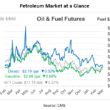Last week’s closure of the UK print edition of Marie Claire prompted daily newspaper columns lamenting the decline of magazines. The monthly, which has been published since 1988 by TI Media (the former Time Inc UK) in a joint venture with Album Marie Claire, has been loss-making for the past few years. In the way of these things, the publisher tried to put on a gloss on the closure by cheerily announcing… “a significant evolution for premium fashion & beauty brand Marie Claire UK that will see it pursue a digital-first future to best serve the changing needs of its audience’s mobile-first, fast-paced, style-rich lifestyles. As part of that digital transformation, the November 2019 issue will be the final print edition of Marie Claire UK.”
Nobody was fooled, but the announcement was significant because it spotlighted the decline of another legendary print brand and of the 56-year-old company which had long been the UK’s largest magazine publisher.
TI had been formed as IPC in 1963 by the merger of three competing UK publishers – Odhams, Newnes, and Fleetway – which, in 1968, added the Daily Mirror newspapers. Incredibly, it became almost a UK monopoly of magazines and popular newspapers, publishing more than 100 magazines, including the country’s four major women’s weeklies together selling some 8m copies, and publications across almost every sector. It also had B2B media, regional newspapers, books, children’s comics, and printing; and was part of a group with sprawling interests across the manufacturing of paper, paint and building materials.
The company’s early years were characterised by Brits as the “Swinging Sixties”. It was boom time for IPC, publisher of the ultra-chic Nova among its raft of hot magazines for fashionable times. But, then, the serious competition began, fuelled by new full-colour printing presses, the soaring growth in advertising revenue, in UK living standards – and IPC’s own profits.
Competitive magazines started to come thick and fast, through the expansion of UK regional publisher EMAP, BBC launches of TV-linked magazines, the arrival of German publishers Gruner & Jahr and Bauer, and the expansion of the privately-owned Hearst and Conde Nast, from the US. It became easy to lampoon IPC as the “Ministry of Magazines” in a tower block – bigger, richer and maybe slower moving than its newer, smaller, more agile competitors. But the company gave British readers the pioneering men’s magazine Loaded, Look & Learn, Essentials, What’s On TV, the market’s steadiest presence Country Life – and Marie Claire.
IPC was milked for high-margin profits, first by the Reed International/ Elsevier conglomerate and then by the Cinven private equity firm which bought it for £860m in 1998. Having flirted with the whizzy dotcom idea of merging IPC with a digital wunderkind (notably, Future Plc in 1999), Cinven managed to sell it for £1.2bn in 2001 to Time Warner, which had just merged with AOL. That US merger of the highly-profitable print publisher with the loss-making digital native was still being hailed as a perfect marriage of new-old media. So, the Time-IPC combination was also considered to be a pretty smart move – but not by everyone..
Time Inc had, for over 60 years, been a different kind of magazine publisher, of major weeklies like Time, Fortune, Sports Illustrated, Life, People, and Entertainment Weekly. It had become the largest magazine publisher in the US by flying high above the hyper-competitive and fragmenting markets for women’s and specialist magazines. Some good folks at Time Inc clearly did not quite see it that way. In 1995, they paid a then publishing record $498m for Alabama-based Southern Progress, which brought magazines like Southern Living, Coastal Living, and This Old House. That entry into the ‘new’ world of niche magazines led directly to the UK acquisition of IPC six years later.
But the unbridled enthusiasm for magazines large and small, inevitably, did not survive the quick succession of Time Warner chiefs drafted in to unravel the AOL fiasco. Time Warner chairman Jeff Bewkes described the AOL merger as “the biggest mistake in corporate history”. He also regarded the magazine deals as strategic mistakes, albeit less pricey ones. By 2018, Time Inc had been acquired by Meredith for $3.2bn (now looking suspiciously like a mistaken purchase of another era). The new owner, in turn, sold IPC on to Epiris private equity for £106.7m, having been forced to pay off the pension fund deficit and some expensive leases. It felt like a buyers’ market.
Epiris partner Chris Hanna said his company would streamline its portfolio and bring “clarity and simplicity” to focus on the most profitable brands. It has closed or sold up to 10 magazines, including sometime best-sellers Look, Now, NME, Uncut, SoapLife, and InStyle. It has also continued to make big cuts in staffing and overheads under high-rated CEO Marcus Rich (ex DMGT and EMAP). But any radical streamlining of the portfolio may (or may not) have been interrupted by the sudden departure of TI chairman Bernard Gray after just nine months. The question now is whether new chair Tim Weller (founder of Incisive Media) could be planning a completely new strategy almost two years after the Epiris acquisition.
Although TI Media’s 40+ print and digital-only brands claim to reach 11m UK adults (some 50% of its heyday), the financials scream the case for a strategic rethink. It’s not just that the £20m operating profit in 2017 (before £23m of reorganisation costs) was only a 9% margin on revenue of £221m.
At least 50% of this profit and 20% of the revenue came just from the company’s two listings weeklies What’s on TV and TV Times. Together with the weeklies Country Life, Chat and Horse & Hound, and the monthly Women & Home and Ideal Home, these seven brands generate at least 100% of TI Media’s profit. And they may account for only 50% of the company’s 1,100 headcount.
While TI may have substantial growth strategies for potentially major international brands like Wallpaper, Decanter and Trusted Reviews, this is a publisher with a long tail of magazines including no fewer than five yachting and boating brands which have revenues of some £5m but little profit. Diverse magazines like Amateur Photographer, Angler’s Mail, Rugby World, Cycling Weekly, Amateur Gardening, World Soccer, Rugby World, Mountain Bike Rider, and Golf Monthly provide patches of profit but stretch the management team. Locating most of these magazines in low-cost out-of-town offices seems like a fudge.
Then, there’s the Marketforce magazine distribution arm which claims a 30-40% share of magazine marketing and distribution in the UK through its TI and external publisher clients. But it has profit margins of less than 5%, low growth prospects, and may account for more than 10% of the whole company’s headcount. In previous decades, the very profitable Marketforce represented a strategic advantage for IPC/Time – and also for its publisher clients. But such services have been commoditised by the narrowing of retail outlets and sharply reduced magazine sales. The continuing fall-off seems likely to encourage UK competition regulators to permit a merger of the two largest distributors – if they want it.
It’s another legacy issue for TI whose challenges arise from the simple fact that the company’s portfolio was put together during times when there were substantial economies of scale across advertising, sales, distribution and even printing: big publishers really had advantages. The inexorable move to digital media dictates a more bespoke approach to individual markets where publishers can diversify revenues into brand licensing, events, e-commerce and even complementary B2B services. The publisher must be able to compete head-on and digitally with sector specialists, instead of spreading itself thinly across low-growth brands. That’s the case for a TI Media re-focus – and divestment, even of many brands that remain profitable.
The inevitable challenge may be to re-build TI Media round a core portfolio that will at least maintain the level of profits currently generated by the company’s sprawling portfolio. That’s the best argument for divesting much of the special interest magazine portfolio. The strategy could be designed specifically to free-up the TI management (and funding), by:
- Building an investment portfolio of stakes in one or more independent publishers, funded by the transfer to them of TI’s non-core brands
- Merging Marketforce with competitor Frontline/Seymour
- De-centralising overheads in order to drive the remaining portfolio as low-cost, semi-autonomous ‘integrated’ media groups
- Seeking partnerships, strategic alliances and JVs to accelerate digital, events, merchandising and international activity across the core portfolio.
The whole process could help management to concentrate on the unmistakeable opportunities and challenges of TI’s best brands, while turning the corporate headache of its smaller magazines into investments managed by individual entrepreneurs.
Such an approach could revitalise TI Media. Neither the publisher nor private equity owner need reminding that even their golden magazine What’s On TV has lost 18% of its copy sales in the past four years to the lower-priced TV Choice from Bauer, and that Woman & Home is being strongly out-sold by Hearst’s Good Housekeeping with a 40% lower subscription price. The clock is ticking.




